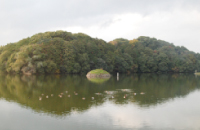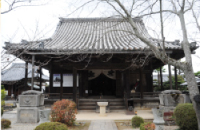Episode 1:
Mission Accomplished, But Not in Time
From the Kojiki, Volume II
“Tajimamori”
This is a story from the era of Ikumeiribiko-isachi-no-Mikoto (Emperor Suinin). A man named Tajimamori, descendant of a prince from the Silla Kingdom in Korea, served the Emperor. One day, the Emperor ordered Tajimamori to go in search of a magical fruit called tokijiku no kaku no konomi, which was said to exist in the land of Tokoyo-no-kuni.
Tokoyo-no-kuni was a utopia of eternal youth and immortality, believed to be located far beyond the ocean. This fragrant fruit’s name, tokijiku no kaku no konomi, meant ‘glowing gold eternally’. It was said to bestow eternal youth and immortality. A person who had eaten it would never grow old or die.
The journey to Tokoyo-no-kuni in search of the tokijiku no kaku no konomi was so arduous it took ten years. When Tajimamori finally returned to the capital, he found that the Emperor had already died.
On learning of the death of the Emperor, Tajimamori offered half of the fruit to the Empress, and offered the other half at the Emperor’s tomb, announcing in tears that he had performed his duty. His sorrow was so deep that he eventually died from remorse. Tokijiku no kaku no konomi is said to be what we now call tachibana (a kind of citrus). In the Nihonshoki (Chronicles of Japan), the fruit’s name is written as ‘香菓’ (fragrant fruit). In olden times, ‘菓’ meant ‘fruit’, but later came to mean ‘sweets’. So, Tajimamori came to be enshrined as a patron ancestor of sweets.
The remans of Emperor Suinin are said to be in the Hōraiyama-kofun tumulus, located in Amagatsuji, Nara City. The small island in the moat, close to the Emperor’s tomb mound, was said by later generations to contain the tomb of Tajimamori. In autumn, the surrounding citrus trees glow gold as if they are the candlelight for the reposing souls of the Emperor who long for Tajimamori’s return, and Tajimamori, who fulfilled his mission but not in time.
Related tourism sites:
Suinin Tenno-ryo (Hōraiyama-kofun tumulus), Amagatsuji-nishi-machi, Nara City
A large keyhole-shaped tomb located near Toshodai-ji Temple, Nishinokyo.
In its moat there is a small island, reputedly the site of Tajimamori’s tomb.

Tachibana-dera Temple, Tachibana, Asuka Village
Tachibana-dera Temple was named in view of the legend that Tajimamori planted in this place the seeds of Tokijiku no kaku no konomi which he had brought back from his travels. The shape of the foundation stone of the central pillar in the five-storied pagoda also seems based on the shape of the tachibana fruit.
